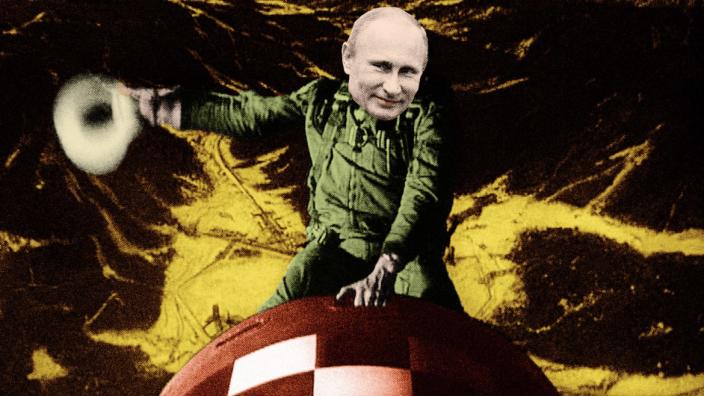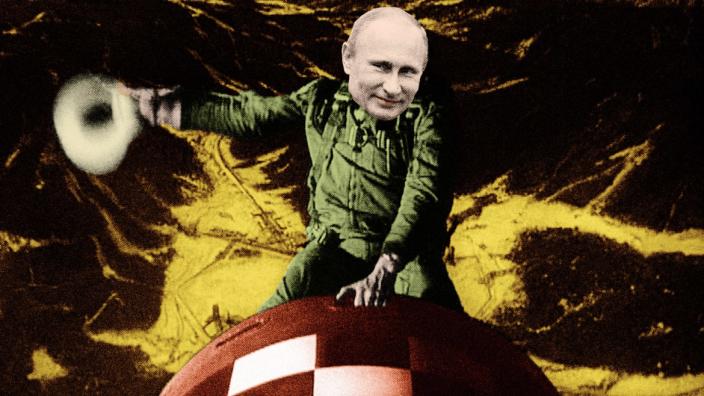
In a rambling and defiant speech on Sept. 20, Russian President Vladimir Putin sent shock waves throughout the international security community by threatening to use tactical nuclear weapons against Ukraine and/or its Western allies. Putin, a former KGB agent, has long felt deep humiliation over the collapse of the Soviet empire in the early 1990s, and is determined to recreate that behemoth at the expense of the sovereignty of his neighbors, most of which are either in NATO, or closely allied with it.
In raising the specter of a nuclear strike, the Russian strongman broke a decades-long unwritten agreement among great-power leaders against issuing nuclear threats in public. That taboo, of course, was formed in the crucible of a grueling series of arms negotiations between the two superpowers during the Cold War. By the mid-1970s, Russia and the United States had reached a clear consensus that the only legitimate use of these weapons was as a deterrent. Small, so-called “tactical” nukes were off the table because their effects were too unpredictable. And intercontinental strikes were nonstarters because of MAD—the doctrine of Mutually Assured Destruction—which boiled down to the realization that a first strike by one power would lead ineluctably to the destruction of both, and a good percentage of the rest of the world to boot.
Threatening to use nukes, even tactical weapons with just a fraction of the power of the atomic bombs dropped on the Japanese in August 1945 by the United States, is an inherently destabilizing and very risky business, for it is widely recognized today that once the nuclear weapons genie is out of the bottle, all bets are off. First use could very well lead to an uncontrollable escalatory cycle, and that could lead to the destruction of much of the planet.
Here’s What Putin’s Nuclear Disaster Would Really Look Like
Putin’s alleged willingness to use nuclear weapons in defense of Ukrainian territory he has “annexed” to Russia is even more pernicious because of the context in which he envisions using them. In his delusional narrative, the war in Ukraine is decidedly not a conflict of imperial expansion by one nation at the expense of another, but rather a defensive war that Russia has been forced to fight not only against Ukraine but also against the Western alliance. Indeed, as he said in his September speech, the Ukrainians are but pawns of “the military machine of the collective West.” According to Michel Eltchaninoff, author of Inside the Mind of Vladimir Putin, the Russian dictator is trying to sell the conflict to his own people as “the defense of the Russian world against the Western attempt at dismemberment.”
” data-src=”https://s.yimg.com/ny/api/res/1.2/Of1PvDpxBHSRJ3.z2sfbiA–/YXBwaWQ9aGlnaGxhbmRlcjt3PTcwNTtoPTUyNg–/https://media.zenfs.com/en/thedailybeast.com/d2ce2829fb45de8e62d56dd218c78801″><img alt="
” src=”https://s.yimg.com/ny/api/res/1.2/Of1PvDpxBHSRJ3.z2sfbiA–/YXBwaWQ9aGlnaGxhbmRlcjt3PTcwNTtoPTUyNg–/https://media.zenfs.com/en/thedailybeast.com/d2ce2829fb45de8e62d56dd218c78801″ class=”caas-img”>
Contributor/Getty
As I write this, almost two months after Putin’s brazen threat was issued, the initial sense of alarm and outrage over his reckless words has diminished considerably, thanks to a growing consensus among nuclear war strategists and intelligence analysts that there is no good strategic rationale for Moscow to use tactical nukes, and that their use would almost certainly be counterproductive for Moscow, militarily and politically. According to nuclear warfare scholar Ankit Panda of the Carnegie Endowment for International Peace, “the way in which Ukraine has been executing combined-arms warfare with dispersed infantry units and dispersed mechanized units, the use of tactical nuclear weapons to achieve military advantage is very difficult for me to imagine… I think everything we’ve seen out of Ukraine suggests that the use of nuclear weapons would have the effect of simply galvanizing Ukraine even more than we’ve already seen.”
Using a nuclear weapon would likely isolate Moscow from its few remaining international friends, especially China. As the Institute for the Study of War, a Washington-based think tank, put it in a recent analysis, “Russian nuclear use would be a massive gamble for limited gains that would not achieve Putin’s stated war aims.” Recently, even Putin himself seemed to recognize this. On Oct. 27, he said publicly, “There is no point in [using tactical nuclear weapons], political, nor military.”
In this context, Putin’s threats seem more a reflection of his pique over just how badly the war is going for Russia than any real intention to pull the trigger on a weapon. And make no mistake: the conflict is slowly turning into a nightmare for Moscow, and for Putin personally. For it is more Putin’s war than Russia’s, and the delusions that underlay his thinking about the nature of the war and the enemy go far in explaining why the initial assault on Kiev failed; why Russian forces have been consistently outmaneuvered by those of Ukraine, and then outfought on the ground.
” data-src=”https://s.yimg.com/ny/api/res/1.2/OM00OLYDkv5GRxKoVwJuZg–/YXBwaWQ9aGlnaGxhbmRlcjt3PTcwNTtoPTQ3MA–/https://media.zenfs.com/en/thedailybeast.com/d28a2dccd644410e14a3eae422ac175a”><img alt="
” src=”https://s.yimg.com/ny/api/res/1.2/OM00OLYDkv5GRxKoVwJuZg–/YXBwaWQ9aGlnaGxhbmRlcjt3PTcwNTtoPTQ3MA–/https://media.zenfs.com/en/thedailybeast.com/d28a2dccd644410e14a3eae422ac175a” class=”caas-img”>
Contributor/Getty
As Lawrence Freedman, one of the West’s most distinguished military strategists, put it recently in an issue of Foreign Affairs, “Putin’s war in Ukraine, then, is foremost a case study in a failure of supreme command. The way that objectives are set and wars launched by the commander in chief shapes what follows. Putin’s mistakes were not unique; they were typical of those made by autocratic leaders who come to believe their own propaganda. He did not test his optimistic assumptions about the ease with which he could achieve victory. He trusted his armed forces to deliver. He did not realize that Ukraine was a challenge on a completely different scale from earlier operations in Chechnya, Georgia, and Syria. But he also relied on a rigid and hierarchical command structure that was unable to absorb and adapt to information from the ground and, crucially, did not enable Russian units to respond rapidly to changing circumstances.”
No wonder, then, that Freedman and so many other serious students of modern politics and warfare believe the West needs to resist the temptation to let fear stymie their support for prosecuting the conflict. As Raphael Cohen and Gian Gentile wrote very recently in Foreign Policy, “fear . . . should not drive the Western response to Russia’s nuclear bluster. If Putin is still a rational actor, there are plenty of reasons why he would want to avoid nuclear use. And if he is not, then the West backing off may not make any difference.”
It is heartening, to say the least, that there is no coherent strategic rationale for Putin to use nuclear weapons in anger for the first time since 1945.
That’s the good news.
The bad news is that despite all the elaborate security systems and protocols developed by nuclear powers to manage these horrendously destructive devices, it’s entirely within the realm of the possible that someday soon, a nuclear weapon may well be put into play, by either accident or malicious design. Ankit Panda at the Carnegie Institute for peace said recently in an interview that he is “rather pessimistic” about the global nuclear order for the next few decades. “I think that the nuclear taboo has weakened not only as a result of what we’re seeing this year between Russia and Ukraine but also because of the development of new capabilities in North Korea and intensifying U.S.–China competition. China has built up its own nuclear capabilities and I think we are potentially looking down the barrel of a return to Cold War-style nuclear dynamics, in the sense that the salience of nuclear weapons to our day-to-day lives is going to grow substantially.”
And with more and more countries trying to build nuclear capability or buy it, there is an increasing chance that one day such a weapon will indeed be detonated. Stanley Kubrick’s hilarious dark comedy, Dr. Strangelove: Or How I Learned to Stop Worrying and Love the Bomb, in which a renegade American general starts a nuclear conflagration, is once again surprisingly relevant. The film was roundly dismissed by various national security officials when it first came out in 1964 as pure farce that could never, ever happen in the real world. But it’s now widely recognized that Kubrick’s masterpiece astutely revealed a terrifying truth: Shit happens! People in positions of high authority—even rigorously trained and vetted people—do indeed lose their grip on reality. They develop obsessions, resentments, and sinister schemes of retribution.
In the film, of course, it’s Sterling (former SOS operative) Hayden’s General Jack T. Ripper, commander of a wing of B-52s, who goes “a little funny in the head” and launches his entire wing to attack their targets inside Russia. Ripper has come to believe that retribution must be rendered, for the “monstrous plot” that the Soviets have foisted upon the American people. Through fluoridation of the water supply, the Ruskies have “sapped and impurified our precious bodily fluids.”
” data-src=”https://s.yimg.com/ny/api/res/1.2/JLiD4aVgc6Ni12gBN8gaJQ–/YXBwaWQ9aGlnaGxhbmRlcjt3PTcwNTtoPTQ4NA–/https://media.zenfs.com/en/thedailybeast.com/5d574b9151610f52af54c3930717b3a0″><img alt="
” src=”https://s.yimg.com/ny/api/res/1.2/JLiD4aVgc6Ni12gBN8gaJQ–/YXBwaWQ9aGlnaGxhbmRlcjt3PTcwNTtoPTQ4NA–/https://media.zenfs.com/en/thedailybeast.com/5d574b9151610f52af54c3930717b3a0″ class=”caas-img”>
Columbia Pictures/Alamy
Since Ripper is the only person who knows the three-letter recall code to bring the wing back, and he isn’t saying, the planes cannot be recalled by President Merkin Muffley (Peter Sellers), despite heroic efforts to do so. The insane Ripper kills himself, but not before urging the National Security Council and the president to send the rest of SAC’s (Strategic Air Command) bombers against targets in Russia immediately “or face total annihilation. . .”
And so the door opens for a nuclear exchange in the film that ends history as we know it.
Upon assuming office, John F. Kennedy was astonished to learn that it was indeed quite possible for a limited number of commanders in SAC, as well as submarine captains, to launch a nuclear attack without presidential approval. Moreover, many nuclear weapons in Europe roved around the continent, where they could be easily accessed by NATO officials and launched without Kennedy’s consent. It wasn’t until the 1970s that switches requiring codes were affixed to U.S. missiles and bombs of the nuclear variety.
According to Eric Schlosser, writing in The New Yorker in 2014, “The security measures now used to control America’s nuclear weapons are a vast improvement over those of 1964. But, like all human endeavors, they are inherently flawed. The Department of Defense’s Personnel Reliability Program is supposed to keep people with serious emotional or psychological issues away from nuclear weapons—and yet two of the nation’s top nuclear commanders were recently removed from their posts. Neither appears to be the sort of calm, stable person you want with a finger on the button. In fact, their misbehavior seems straight out of Strangelove.”
Great films on occasion reveal truths about the real world we’d rather dismiss as fantasy, and certainly this holds true for Kubrick’s comic masterpiece.
Get the Daily Beast’s biggest scoops and scandals delivered right to your inbox. Sign up now.
Stay informed and gain unlimited access to the Daily Beast’s unmatched reporting. Subscribe now.




